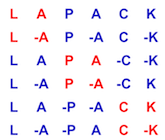 |
LAPACK 3.12.1
LAPACK: Linear Algebra PACKage
|
 |
LAPACK 3.12.1
LAPACK: Linear Algebra PACKage
|
| subroutine slaed1 | ( | integer | n, |
| real, dimension( * ) | d, | ||
| real, dimension( ldq, * ) | q, | ||
| integer | ldq, | ||
| integer, dimension( * ) | indxq, | ||
| real | rho, | ||
| integer | cutpnt, | ||
| real, dimension( * ) | work, | ||
| integer, dimension( * ) | iwork, | ||
| integer | info ) |
SLAED1 used by SSTEDC. Computes the updated eigensystem of a diagonal matrix after modification by a rank-one symmetric matrix. Used when the original matrix is tridiagonal.
Download SLAED1 + dependencies [TGZ] [ZIP] [TXT]
!> !> SLAED1 computes the updated eigensystem of a diagonal !> matrix after modification by a rank-one symmetric matrix. This !> routine is used only for the eigenproblem which requires all !> eigenvalues and eigenvectors of a tridiagonal matrix. SLAED7 handles !> the case in which eigenvalues only or eigenvalues and eigenvectors !> of a full symmetric matrix (which was reduced to tridiagonal form) !> are desired. !> !> T = Q(in) ( D(in) + RHO * Z*Z**T ) Q**T(in) = Q(out) * D(out) * Q**T(out) !> !> where Z = Q**T*u, u is a vector of length N with ones in the !> CUTPNT and CUTPNT + 1 th elements and zeros elsewhere. !> !> The eigenvectors of the original matrix are stored in Q, and the !> eigenvalues are in D. The algorithm consists of three stages: !> !> The first stage consists of deflating the size of the problem !> when there are multiple eigenvalues or if there is a zero in !> the Z vector. For each such occurrence the dimension of the !> secular equation problem is reduced by one. This stage is !> performed by the routine SLAED2. !> !> The second stage consists of calculating the updated !> eigenvalues. This is done by finding the roots of the secular !> equation via the routine SLAED4 (as called by SLAED3). !> This routine also calculates the eigenvectors of the current !> problem. !> !> The final stage consists of computing the updated eigenvectors !> directly using the updated eigenvalues. The eigenvectors for !> the current problem are multiplied with the eigenvectors from !> the overall problem. !>
| [in] | N | !> N is INTEGER !> The dimension of the symmetric tridiagonal matrix. N >= 0. !> |
| [in,out] | D | !> D is REAL array, dimension (N) !> On entry, the eigenvalues of the rank-1-perturbed matrix. !> On exit, the eigenvalues of the repaired matrix. !> |
| [in,out] | Q | !> Q is REAL array, dimension (LDQ,N) !> On entry, the eigenvectors of the rank-1-perturbed matrix. !> On exit, the eigenvectors of the repaired tridiagonal matrix. !> |
| [in] | LDQ | !> LDQ is INTEGER !> The leading dimension of the array Q. LDQ >= max(1,N). !> |
| [in,out] | INDXQ | !> INDXQ is INTEGER array, dimension (N) !> On entry, the permutation which separately sorts the two !> subproblems in D into ascending order. !> On exit, the permutation which will reintegrate the !> subproblems back into sorted order, !> i.e. D( INDXQ( I = 1, N ) ) will be in ascending order. !> |
| [in] | RHO | !> RHO is REAL !> The subdiagonal entry used to create the rank-1 modification. !> |
| [in] | CUTPNT | !> CUTPNT is INTEGER !> The location of the last eigenvalue in the leading sub-matrix. !> min(1,N) <= CUTPNT <= N/2. !> |
| [out] | WORK | !> WORK is REAL array, dimension (4*N + N**2) !> |
| [out] | IWORK | !> IWORK is INTEGER array, dimension (4*N) !> |
| [out] | INFO | !> INFO is INTEGER !> = 0: successful exit. !> < 0: if INFO = -i, the i-th argument had an illegal value. !> > 0: if INFO = 1, an eigenvalue did not converge !> |
Definition at line 159 of file slaed1.f.